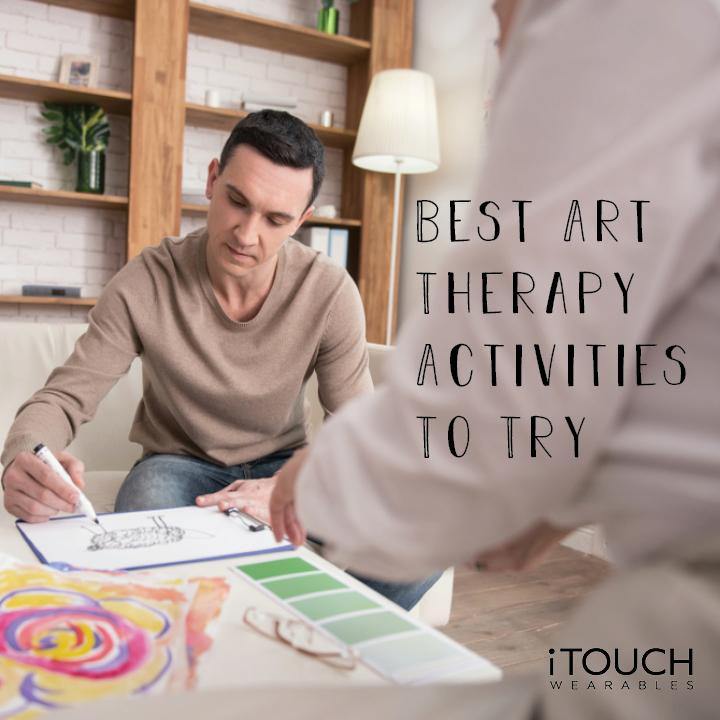
Best Art Therapy Activities To Try
When was the last time you picked up a paintbrush or a colored pencil, sat down, and actually spent time to draw or paint something? Maybe it’s been a while, but what about the times you find yourself doodling in your notebook during a meeting? For many of us, when it comes to getting creative and getting a little messy, we are often put off by the idea because we are nervous about the end result. However, there is a ton of good that can come out of getting a little messy with your paints! Allowing our brains the freedom for some free expression, even by doodling, can have a wonderful impact on how we process, retain, and share information. It’s no surprise that the therapy community has taken note of this, and in more recent years, there has been a rise in the number of practitioners offering a very distinct form of therapy: Art Therapy. Within this blog post, we will dissect exactly what art therapy is, and how you can make the most out of its practices whether at home or at the office! Here is our guide for the best art therapy activities to try!
What Is Art Therapy

Art therapy is a blended field of therapeutic practice that combines art and psychology. Within its practices, it utilizes the creative process, artistic techniques, and external artwork to support individuals to develop self-awareness, explore emotions, and address unresolved conflict or trauma. Art therapy, at large, has also been used to help individuals, particularly young children, develop social skills and raise self-confidence. It’s a fantastic addition within positive psychology as, at its core, it seeks to help individuals overcome emotional or psychological challenges to achieve a greater sense of personal well being.
In wanting to participate in art therapy, you do not need any experience with art or a "natural" artistic ability. When sitting down and approaching its practices, the process, within itself, should be one of exploration with no "wrongs" and no "rights." The practice allows each individual to use creative activities in ways that support them best without judgment.
Art Therapy can be used to:
- Improve Cognition
- Improve Sensory-Motor Function
- Cultivate Emotional Resilience
- Foster Self-Awareness
- Foster Self-Esteem
- Promote Insight
- Enhance Social Skills
- Reduce Conflict
If you are interested in Art Therapy, here are some art therapy activities to try at home!
1 - Words To Live By Collage

We are often our own worst enemy, often letting our insecurities, doubts, and frustrations get in the way of living up to our fullest potential. The ‘Words to Live By’ activity helps to visualize positive core values through creative collage. Here’s how to do this activity:
Gather Together:
- Old magazines, newspapers, picture books, and scrap paper
- Colored pens and pencils
- Scissors and glue
- Cardboard or thick paper for the base of the collage
Directions:
- Before you begin, take a moment to reflect on your core values. Think about what some things you feel strongly about are. What makes you feel good. Once you have a good idea of your values, take a mindful minute. Close your eyes and turn your focus to the breath. Now ask yourself to let the words associated with your values freely flow into your thoughts. What are these words? What are the related images or colors and shapes you feel connected to these words?
- Once ready, begin selecting images, words, phrases, or colors from the magazines and newspapers. Start building your collage, seeing your values come to life.
2 - Self-Care Box

Affirmation and inspiration are the keys to the self-care box. It can be comforting to have something small, tangible, and beautiful in times of trouble. This is a simple activity that can have impactful results at times of need. Here’s how to make a self-care box.
Gather Together:
- Wooden Box or Cardboard Box
- (Wood) Paints, Markers, or Construction Paper
- Materials such as Lace, Sequins, Tulle, or Cotton
- Old Magazines, Picture Books, Newspapers, or Visuals
- Scissors and Glue
Directions:
- Reflect on your ideas of self-care. What does it mean to you? What are some of the things, behaviors, people, or activities that help you feel good about yourself and that feel like self-care? Think about the emotions, feelings, words, and images or colors that these ideas for self-care evoke within you.
- Start decorating your box to best align it with your ideas of self-care. Decorate or line the box with positive affirmations. These can be self-generated or found online. These can also be simply folded and put into the box to be read when needed.
- Use the box for items that provide comfort, like worry stones, pictures of friends or family, clips of quotes or poetry, pressed flowers, or treasured jewelry or mementos. Fill the box with items such as face masks, special gift-cards to your favorite places for when feeling blue, or other goodies to help.
3 - The Panic Book Activity

People with anxiety disorders can spiral into a panic by just thinking about the possibility of having a panic attack. Panic attacks can have many triggers, sometimes known, but often not. The Panic Book activity encourages participants to create a book full of images that can help them to feel calm, as a way to keep calm during stressful situations and to help refocus their mind onto something more positive.
Gather Together:
- Artist Sketchbook or Notebook
- Colored Pens, Markers, Pencils, Paints
- Magazines, Newspapers, Old Picture Books
- Images or Resources That Make You Happy and Feel Calm
Directions:
- Begin finding resources for your panic book. When you do, start creating your book, filling the pages with certain themes for different sections of the book such as the beach, favorite places, and people, or nature scenes.
- You do not need to fill the entire sketchbook in this one session. This is something you can come back to over time and add to as you find more words and images that evoke feelings of calm and comfort for you.
- Keep this book close with you, so if you feel a moment of panic approaching, you can refer to it as a resource to help distract you and focus on the things that evoke calm emotions.
While these might not provide comfort for everyone, we advise you to find resources of your own or to try out these projects to help out!
Share with us what art activity you would like to try by following us on Instagram @itouchwearables and Facebook @itouchwearables and by dropping a comment and like. Also, be sure to check out our new articles published daily and the latest styles on iTouchWearables.com!
-Patrick


